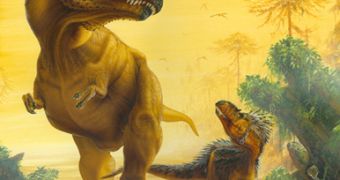Bones had already shown a tight connection between the carnivorous dinosaurs and birds. The discovery of the feathered dinosaurs further confirmed this.
But this really tops it off.
Scientists managed to compare fossil proteins extracted from a 68-million years old femur bone of an young Tyrannosaurus female to living vertebrates, strengthening the idea that indeed, birds are living dinosaurs.
This fossil collagen is the oldest preserved protein ever found. Collagen is the main compound of animal connective tissue, found in skin, cartilage, ligaments, tendons, hooves, bones and teeth. "I mean can you imagine pulling a bone out the ground after 68 million years and then getting intact protein sequences?" said lead author John Asara of Beth Israel Deaconess Medical Center and Harvard Medical School. "That's just mind boggling how much preservation there is in these bones."
Previously, the oldest known protein, also a collagen, was discovered in a 100,000- to 300,000-year-old mammoth bone. "It's very, very, very controversial because most people have gone on record saying there's an absolute time limit to anything that's protein or DNA," said Mary Schweitzer, a molecular paleontologist at North Carolina State University.
But many researchers support the finding. "Here are the pieces of the protein. If you're going to refute this you have to explain how these pieces got in there," said Matthew Carrano, a dinosaur curator at the Smithsonian Institution in Washington, D.C. "It's not another molecule mimicking the protein and giving off a similar signal. This is the actual sequence."
The T. Rex leg bone was discovered in 2003 in the Hell Creek Formation, a fossil rich area spreading over Montana, Wyoming and North and South Dakota.
In 2005, Schweitzer's team discovered the soft tissue inside the fossilized dinosaur femur. Usually, the hard stuff is all that is preserved from a bone when a dead body is fossilized as germs dissolve all the soft tissue, so this was a breakthrough. "For centuries it was believed that the process of fossilization destroyed any original material, consequently no one looked carefully at really old bones," Schweitzer said.
Schweitzer discovered the old tissue reacted with collagen antibodies from birds' tissues. High-powered microscopes images revealed a chemical structure resembling collagen fibers. Asara employed mass spectrometer, proving that the chemical was indeed collagen.
When his team compared the amino-acid sequence of the T. rex collagen to sequences from modern species, it appeared a significant similarity to that of birds. "I'm grateful that he was able to get the [amino acid] sequences out," said Schweitzer. "Here we have a real molecule from a real dinosaur, and it's much more similar to a bird than it is to anything else," Carrano said.
The finding could boost an array of studies once thought to be impossible, and fossil proteins could offer more solid and direct proofs about evolutionary links between living and extinct organisms. "Protein sequences often reflect little bits of the evolutionary history of animals, how they are different or similar among groups," Carrano said.
"This can provide information for extinct animals on how they are related through evolution to living groups of animals if we could pull out these kinds of molecules."

 14 DAY TRIAL //
14 DAY TRIAL //